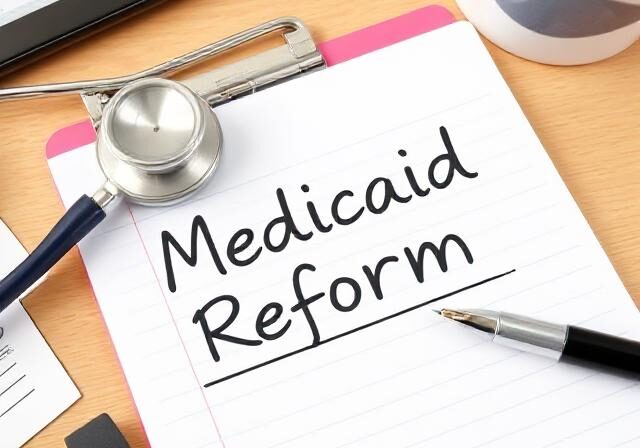Medicaid Reform Analysis: What the ‘Big Beautiful Bill’ Actually Does in Montana
Policy analysis examines federal reforms affecting 218,000 Montanans enrolled in Medicaid

By Dr. Roger Stark, Mountain States Policy Center
Jul 7, 2025
President Trump recently signed H.R.1, aka the “One Big Beautiful Bill Act,” into law. The basis of the bill is an extension of the 2017 tax relief. Also included in the new law is the first substantial reform to the Medicaid health insurance entitlement. Despite claims that “the sky is falling,” the Medicaid reforms are actually a start at guaranteeing that the program will survive into the future and be available for the country’s most vulnerable people.
Opponents decry the “cuts” to Medicaid. In reality, the new law actually reduces an INCREASE in spending from four percent to two percent. Only convoluted accounting would define an increase in spending as a “cut.” Medicaid spending was $900 billion last year and has increased by 60 percent since 2019. The non-partisan Congressional Budget Office (CBO) estimates that even with H.R.1 in place, Medicaid will grow by $200 billion over the next decade.
Medicaid began in 1965 as a 50/50 financial partnership between states and the federal government. It was focused as a health insurance safety net for the country’s poor and disabled. Obamacare in 2014 gave states the option of expanding the entitlement to any able-bodied, low-income individual between the ages of 18 and 64. The enticement for the states was a 90 percent contribution from the federal government.
The program has never undergone significant reforms and in many states now functions as a piggy bank for not only taxpayer-funded health insurance, but also spending on housing, transportation, and food supplements.
So, what are the Medicaid reforms in H.R.1? For starters, the law adds a work requirement for single, able-bodied individuals and recipients with children over the age of 13. The requirement is 80 hours per month and can include community service or education. Estimates vary, but research shows that potentially 40 percent of the able-bodied Medicaid enrollees could work but don’t.
H.R.1 also includes a cost-sharing provision. Recipients will need to pay $35 as a co-pay for a provider visit, a medical test, or treatment. The out-of-pocket amount cannot exceed five percent of a family’s annual income.
The law also tightens up eligibility checks. Instead of relying on states to determine the timing of compliance checks, H.R.1 requires that states confirm eligibility every six months.
For years, states have been gaming Medicaid by using a provider tax. Hospitals pay a Medicaid tax, which shows higher state spending on Medicaid. This in turn, precipitates a higher financial match from the federal government. The state then pays hospitals a higher Medicaid fee. The whole scheme is essentially legalized fraud. H.R.1 drops the acceptable tax from 6 percent to 3.5 percent. As a payback to hospitals, the law sets aside $50 billion for rural hospitals. It is unclear how those funds will be dispersed.
There are currently a staggering 83 million people, or 25 percent of the U.S. population, enrolled in Medicaid. Remember, Medicaid was supposed to be a health insurance safety net for low-income individuals and families.
The estimates of the number of people who will lose health insurance because of H.R.1 have no foundation in reality. The CBO estimate, which is the most widely published, comes in at approximately 11 million people by 2034. Almost 5 million are estimated because of non-compliance with the work requirement, and another 1.4 million because they are not U.S. citizens. Millions more are expected due to unwillingness to do the necessary eligibility verification paperwork.
There are two issues here. First of all, no one knows exactly how many people would be dropped from Medicaid. The numbers seem frightening, but are also being promoted by opponents of any Medicaid reform. Secondly, there is no way to know how many people who lose Medicaid would simply find other sources of health insurance.
Opponents of H.R.1 believe that the law will “gut” the Medicaid entitlement. However, Medicaid must be reformed if it is going to survive as a health insurance safety net for the most vulnerable, as originally intended. Medicaid is now one of the largest non-discretionary budget items for the federal government and is one of the three largest budget items for every state.
The “One Big Beautiful Bill Act” is a long-overdue beginning at Medicaid reform. The program needs to return to its roots as a helping hand for the most vulnerable and not be used as a Trojan horse for government-provided single-payer healthcare.
This analysis was originally published by Mountain States Policy Center.

Dr. Roger Stark is a visiting fellow with Mountain States Policy Center, an independent research organization based in Idaho, Montana, eastern Washington and Wyoming. A retired surgeon, Stark has authored three books including “Healthcare Policy Simplified: Understanding a Complex Issue,” and “The Patient-Centered Solution: Our Health Care Crisis, How It Happened, and How We Can Fix It.”
Stay in the loop—or help power the reporting
Get stories like this delivered to your inbox—or become a supporter to help keep local news bold and free.

So they can’t work 80 hrs per montht what a joke most of these welfare recepients are more than able to do SOMETHING outgside of pack their mouths. they have used this systenmas a way of life too long.